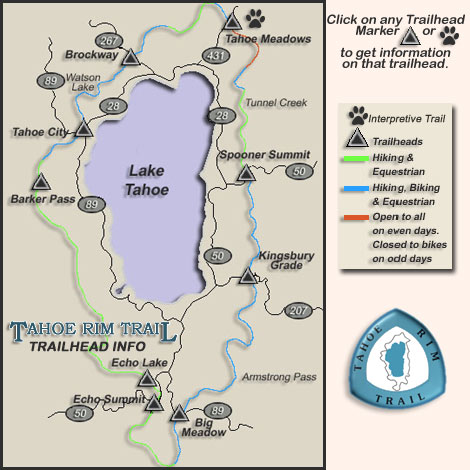Meiss Country Trails
Big Meadow Trail to Scotts Lake- Difficulty: Easy
- Elevation: 7,200'/8,000'
- Mileage (one-way):2½ miles
- Follow directions to Round and Dardanelles Lake until you reach the Scotts Lake trail junction approx. ½ mile after the tail begins. Here the trail climbs upward at a gradual pace through limber pine, Jeffrey pine, and fir, high above Big Meadow. A great hike in the fall, the trail travels through a beautiful aspen grove which opens into a valley covered with juniper and sagebrush. A short distance further, the trail turns into an old jeep road, leading to Scotts Lake.
Big Meadow Trail to Round Lake- Difficulty: Moderate
- Elevation: 7,200'/8,070'
- Mileage (one-way):2.7 miles
- Take Hwy. 50 to Hwy. 89 to the Big Meadows parking lot on the left. Follow the trail at the lower end of the parking lot approx. 200 yards, where it intersect with the highway. Cross the highway cautiously and look for the trailhead signboard. The first ½ mile of this trail climbs steeply from the highway through Jeffrey pine and white fir to Big Meadow. After crossing the creek and a large meadow, the trail enters the cover of a Lodgepole cloaked forest. In another 1½ miles, the trail descends nearly 250' along an aspen-covered bank to a junction. Take the left fork which leads by a wall of interesting volcanic rock. After another short climb up a small hill, the trail leads to Round Lake, Meiss Country's largest lake. The brownish-green lake is a great place for a refreshing swim or for trying your hand a catching some cutthroat trout.
Big Meadow Trail to Dardanelles- Difficulty: Moderate
- Elevation: 7,200'/7,760'
- Mileage (one-way):3½ miles
- Aspen and alder trees along the trail make this an exceptionally scenic hike during the fall. Follow directions from the previous hike trailhead. When the trail forks approx. 1½ miles past Big Meadow, take the right fork. In less than a ½ mile, take the unmarked trail to your left which crosses the creek. The trail winds though rolling hills and past willows before crossing two more streams. Look for the giant seven foot in diameter juniper along the way. A short climb up a small hill leads you to Dardanelles Lake, surrounded by picturesque granite cliffs on one side and flat granite shelves on the other.
Hwy. 88 to Meiss Lake- Difficulty: Moderate
- Elevation: 8,560'/8,320'
- Mileage (one-way):4 miles
- Take Highway 50 south from South Lake Tahoe to Highway 89 and turn left. Continue to the intersection of Highway 89 and 88 and turn right. continue past the Carson Pass Sno-Park one mile, turn left on the dirt road and park in the dirt parking area. The trailhead is located on the other side of the highway just across from the parking area. Follow the trail up a hillside covered with mule ear and sagebrush to a saddle, providing views of the surrounding peaks. At this point the trail follows an old jeep route, crosses the Upper Truckee River and leads into a large meadow. Follow the path to the right ,6 miles down the gentle slopes to Meiss Lake. A shallow but scenic lake, Meiss is one of the warmest lakes in the Tahoe area, making it a great place for chest deep swimming. Fishing is not allowed in Meiss Lake.
Hwy. 88 to Showers Lake- Difficulty: Moderate
- Elevation: 8,560'/8,790'
- Mileage (one-way):5.1 miles
- Follow directions to the trailhead from the previous hike. Showers Lake is the highest in the Upper Truckee River Basin. Follow the Pacific Crest Trail through expansive meadows with views of Round Top (10,381'), Elephant's back (9,585') and Red Lake Peak (10,063'). The trail begins by winding upward through a series of switchbacks for over a mile. After reaching a summit, the trail drops down a steep grade into the flatlands of Meiss Meadows, riddled by many streams in the springtime. At this point, the trail parallels an old jeep trail for about a mile. When you reach a junction, take the left fork which will eventually lead you up a moderate hill, covered with wildflowers in the spring. Reaching the crest, the trail descends to Showers Lake, one of the cooler lakes in the Tahoe area.
PCT from Hwy. 88 to Hwy. 50- Difficulty: Strenuous
- Elevation: 8,560'/7,240'
- Mileage (one-way):13.4 miles
- FA challenging trip, great views of the Upper Truckee River Basin and Lake Tahoe reward the serious hiker. Two cars are needed for a day hike. Plan to leave one car in the Carson Pass area and one at the Echo Summit Sno-Park located on Highway 50. Follow directions from the previous hike to Showers Lake. The Pacific Crest Trail continues across the lake's only outlet at the north end and then begins a steep ascent past an impressive, overhanging volcanic point. Gradually curving northward, the trail crosses numerous creeklets, traverses large meadows and follows forested crests with many ascents and descents. The trail eventually leads to the Echo Summit Sno-Park.
For Information call (530) 525-7982 or (530) 525-7232
For Reservations call (800) 444-7275
Sugar Pine Point State Park is a forested promontory on the western side of Lake Tahoe. Trails serve almost every part of the park. A short loop trail through the Z'Berg Natural Preserve, the Dolder Trail follows the lakeshore and passes the world's highest working lighthouse. For those with more time, the General Creek Trail is a 6 1/2 mile loop, offering an optional side trip to Lily Pond. Lost Lake, a beautiful alpine lake, is a full 15 mile round trip, and should only be tackled by seasoned hikers with ample time (6 to 7 hours).
Dogs must be kept on leash (six foot maximum length) and are allowed only in the developed areas of the park. Dogs are not permitted on park trails.
Those wishing to enter Desolation Wilderness through the park will need to obtain a wilderness permit from the U.S. Forest Service for both day-use and overnight trips. Permits are available at the South Lake Tahoe Forest Service Headquarters, the Taylor Creek Visitor Center, or (when staffed) the William Kent Campground. Day-use permits are available at most Forest Service trailheads.
New fees for overnight camping are now in effect :
- $16 per night
- $75 per night group (40 people per site)
- $75 Annual Pass
- $5 daily/$35 annual parking fee beginning May 22 at Eagle Falls Trailhead
You can obtain the Sierra District's Fall and Winter Hike Schedule by sending a stamped, self-addressed envelope to: Sierra District State Parks, P.O. Box Drawer D., Tahoma, CA 96142.
"There were times we were on top of the rim, literally walking a narrow stretch of trail with landscapes that would rival a great work of art." - Steve Anderson

Trail Use
The Tahoe Rim Trail is one of the world's premier trails and is marketed as a 165 mile loop trail. In reality, it is longer and for Thru-Hikers, you must include road sections. So, for planning purposes, the total mileage is closer to 164 miles.
It is a trail that offers something for everyone. Hiking, horseback riding and skiing are allowed on all portions of the trail. Mountain biking is allowed on the trail with the exception of the wilderness areas, the section that is in Lake Tahoe, Nevada State Park and the the part that is in conjunction with the Pacific Crest Trail. We have provided a very simple map to give you a general idea but we would highly encourage you to order the more detailed map from the Tahoe Rim Trail Store. It is detailed enough to allow you to plan a safe adventure on the trail. In addition if you have been hiking the TRT Association would appreciate feedback on the condition of the trail so that we can schedule maintenance if necessary. Be sure to check out the volunteer opportunities that are available. Going on one of our backcountry work camps can be a great way to have a great vacation while giving back something to the TRTA.
The Tahoe Rim Trail is a backcountry, non-motorized scenic trail. Please enjoy your travels, but leave no trace that you were there! This means low impact camping, pack out your trash, take only pictures. The Tahoe Rim Trail is marked with triangular light blue trail markers with the words "Tahoe Rim Trail" stamped on them. The markers are spaced periodically along the trail as confidence markers and at major trail junctions and road crossings. It is typical to travel several miles between markers. The signs do not always last through each season, so always be prepared with a map and compass.
When is the best time to hike:
The Tahoe Rim Trail is open when the snow has melted off the trail in the summer - usually mid-June and until the snow starts in the fall - usually late October. The best times to hike are early to mid-July for wildflowers and September/October for fall colors. During the winter months, the amount of snow that falls in the Sierra obscures the trail. If you are planning winter travel, you must be prepared for extreme weather and be competent with GPS and quadmaps.
It's a Loop, Where do I start:
If you are planning to hike the entire TRT loop, where you start can be important for planning food & water caches, campsites, and where you park your vehicle, if you drove.
Distance:
The trail is marketed as a 165 mile loop trail. In reality, it is longer and for thru-hikers, you must include road sections. So, for planning purposes, the total mileage is closer to 164 miles.
Starting:
We recommend you take a taxi or have someone drop you off at a trailhead. This will alleviate parking at a trailhead for an extended period of time. If you do drive, you can park at any of the following Tahoe Rim Trail trailheads: Brockway East (off of Forest Service Rd 16N56), Tahoe Meadows Trailhead (Hwy 431), Spooner Summit (North or South), Kingsbury Grade (North or South), Big Meadow Trailhead (Hwy 89), Echo Summit sno-park (Hwy 50 at the summit), Echo Lakes (upper parking lot), or Barker Pass (Forest Service Rd 15N38).
Parking:
Make sure your vehicle is in a designated parking area. Parking in these areas is at your own risk. Neither the TRTA nor the US Forest Service is responsible for your automobile. Please do not leave any valuable items, wallets, etc. in your auto. Tahoe City South (at the Truckee River Recreation & River Access Parking Lot) has a 72-hour parking ordinance. If you need to park here for over 72 hours, contact the Tahoe Rim Trail office to register your car.
Wilderness Permits and Reservations:
You will need a permit to enter the Desolation Wilderness (5. Echo Lakes to Barker Pass section). In 1978, the Forest Service began a quota system in which they limit the number of overnight users from the Friday before Memorial Day through September 30 of each year. You must enter on the date specified on your permit and must spend your first night in the zone which you have chosen. The rest of your stay is not subject to zone requirements. Have some alternative zones in mind in the event those zones are not available. During the quota season, 50% of the quota in each zone may be reserved in advance. The other 50% of the available quota is set-aside for first-come, first-served visitors. These permits must be obtained in person at offices that issue Desolation Wilderness permits and may not be reserved ahead of time. Overnight permits may be reserved by phone, mail, or fax in advance but must be picked up in person. The point is, you will need to get your permit prior to your hike.
Click here for complete trail information ....
TAHOE MEADOWS INTERPRETIVE TRAIL
This 1.3 mile loop trail winds among huge granite boulders and towering pines, crosses sparkling mountain streams, and wanders through a lush alpine meadow. The entire loop is wheelchair accessible.
Trailhead
Tahoe Meadows: 1/2 mile southwest of Mt Rose summit on Hwy 431. Paved parking, vault toilets. Trail begins at lower parking lot. Look for sign for INTERPRETIVE TRAIL. The trail is open by mid-July until the first snowfall in the fall (usually October).
**Bikes and horses are not allowed. This interpretive trail is designed to be a safe, comfortable experience for people of all ages and people in wheelchairs.
Dogs on the Tahoe Rim Trail
Regulations for dogs on the Tahoe Rim Trail:
Nevada State Park - dogs are allowed on the Tahoe Rim Trail in Nevada State Park. They must be under voice command control or on a leash.
National Forest:
Dog restrictions are regulated by each county. However the US Forest Service does not enforce county regulations. The US Forest Service requires that dogs must be under owner control. Dog owner will be cited if the dog is harassing wildlife or has bitten or injured a human.
Remember to pack extra water and even a snack for your dog when they accompany you on a hike or ride.
If you would like to check with the counties on the specific county ordinance, please contact them yourself:
El Dorado County 530-577-1766
Placer County 530-546-4260
Washoe County 775-832-4107
Carson City 775-887-2171
Douglas County 775-782-9935
Alpine County 530-694-2231
 Menu
Menu








